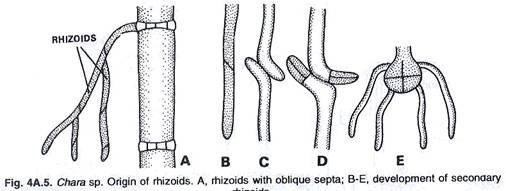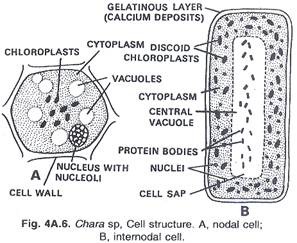The following points highlight the nine common excretory materials of ergastic matters.
They are: (1) Alkaloids (2) Glucosides (3) Tannins (4) Latex (5) Essential Oils (6) Resins (7) Gums (8) Mineral Crystals and (9) Organic Acids.
1. Alkaloids:
Alkaloids are nitrogenous waste products found in many plants. They are supposed to be decomposition products of proteins. Chemically, they are composed of carbon, hydrogen, oxygen and nitrogen.
They occur in storage organs like roots and seeds; in bark, leaves, wood and other parts. Alkaloids are usually insoluble in water, but readily soluble in alcohol. They have bitter taste, and many of them are deadly poisonous.
Alkaloids are the active principles of a large number of medicines derived from the plants. Quinine present in Cinchona bark, reserpine in the root of Rauwolfia serpentina, strychnine in nux vomica seeds, cocaine in coco, caffein in coffea seeds, ephedrine from Ephedra, nicotine in tobacco, are the common alkaloids.
2. Glucosides:
These bear close resemblance with alkaloids in many porperties, but they are decomposition products of carbohydrates. Many glucosides are used in medicine, e.g. digitoxin, the active principle of the important heart stimulant digitalis—Digitalis purpurea of family Scorphulariaceae.
3. Tannins:
These are usually bitter and astringent substances related to glucosides. They occur in the cell-sap of the vacuoles, in the cell wall, in bark and woody parts of plants. Tannins are abundantly present in many fruits like myrobalans, in leaves, seeds, bark and also in pathological galls. The percentage of tannin is usually high in unripe fruits, and it gradually decreases with ripening.
Tannins are almost of universal occurrence in individual cells, in special sacs or forming connected system. They have been noticed even in the meristematic cells. Tannins are used in many industries. They can react with the proteins of animal skins and can produce a hard-substance. For this property they are used for tanning leather.
Further, tannins turn blue-black in colour in contact with iron salts. Thus they are extensively used for manufacture of ink. Some of them have medicinal value as well.
4. Latex:
Latex is usually a milky fluid, often watery or brownish, present in some families of angiosperms. It is really an emulsion with watery background and various substances like proteins, gums, resins, alkaloids, etc., suspended in water.
Dumb-bell- shaped starch grains are frequently noticed in latex. Its utility to the plants is problematic, but it is, at any rate, helpful in healing of wounds. This milky fluid is very valuable as the chief commercial source of rubber.
The majority of plants yielding rubber belong to the families Moraceae, Euphorbiaceae and Apocynaceae. Hevea brazilensis of family Euphorbiaceae needs special mention as a source of rubber.
Latex of papaw contains papain, the enzyme helpful in digestion of protein food. The so-called ‘Cow- tree’ Brosimum galactodendron of family Moraceae of Venezuala yields the latex which is taken by the natives as a substitute of milk.
5. Essential Oils:
These are volatile oils found in many plant parts. They usually occur in special cells or glands. The fragrant odours of many flowers and leaves, of rinds of some fruits, bark and wood of some trees and even of some seeds are due to presence of essential oils.
They are usually extracted by distillation. It goes without saying that these oils are of advantage to the plants in bringing about pollination and dispersal of fruits and seeds by attracting insect visitors.
They are used in manufacture of perfumes, soaps, etc., and also in medicine, e.g. eucalyptus oil from Eucalyptus globulus of family Myrtaceae and valerian from garden heliotrope— Valeriana officinalis of family Valerianaceae, Essential oils may also have antiseptic value.
6. Resins:
Resins are complex in composition and are probably oxidation products of essential oils. They occur in special glands or ducts either alone or in association with gums and essential oils. They are not soluble in water but dissolve in solvents like ether and alcohol.
Resins are of three kinds from commercial point of view. Those which are secreted alone are usually solid brittle substances. They are called hard resins which readily dissolve in alcohol and are abundantly used in paint and varnish industry as waterproofing substance.
Lacquer and shellac are the examples. Resins associated with essential oils are aromatic and more or less liquid in nature. They are known as oleo-resins, e.g. turpentines and Canada balsam. The third kind, called gum resins, are mixtures of resins and gums.
They are usually milky in appearance and may be collected by injuring the plants. The common Asafoetida of Afganisthan, yielding a foul odour and acrid taste is the example. Many resins are used in medicine.
7. Gums:
Gums are decomposition products of cellulose cell wall. They are soluble in water. They are exuded from the plants in natural course as mucilaginous masses or in response to injuries.
They are of considerable commercial value as adhesives, and are also used in other industries. Gum arabic of commerce, an exudate from Acacia Senegal of family Leguminosae is particularly used in medicine as an emulsifier.
8. Mineral Crystals:
Inorganic materials in form of crystals occur as waste products in many plants. They are mainly salts of calcium—as calcium oxalates and carbonates. Silicon crystals remain densely impregnated on the surface of plants belonging to grass family Graminaceae and horse-tails (Equisetum).
Calcium oxalate crystals are practically present in all higher plants. They may occur in any part, but are-more abundant in storage organs, in pith and cortical tissues. Solitary crystals are of varying shapes—rod-like, prismatic, pyramidal, rhomboidal and needle-like.
They can be demonstrated in large number in the papery tunic of onion (Fig. 506A) and in the cortical cells of Leonurus sibiricus (Fig. 506B) of family Labiatae, and many other plants.
Needle-like or acicular crystals in form of bundles, called raphides, are common in the aroids and aquatic plants (Fig. 506 C, D & E) like Pista and water hyacinth. They often occur in special mucilage-containing cells called idioblasts.
The needles are ejected when the mucilage swells causing bursting of the wall of the idioblast. A good number of crystals may remain conglomerated together to produce a roundish crystal- aggregate. They are called sphaerapides or druses. Druses may be seen in plants like Pislia, papaw (Fig. 506 D & F), etc.
They may occur in the vacuoles, in the lumen of the cell, occupying a part of it and often completely filling up the cell. Small solitary crystals often remain together forming what is called crystal sand (Fig. 506G).
Calcium carbonate crystals are less common, as they usually occur in the epidermis impregnating a portion of cellulose cell wall. In India rubber (Fieus elastica) or banyan these crystal-aggregates are found in the form of a bunch of grapes.
In fact, the epidermis here is multiseriate and some cells of the innermost layer enlarge, and calcium carbonate crystals remain aggregated on a peg-like projection of the cellulose wall inside the enlargement (Fig. 507A).
Such a crystal-aggregate is called cystolith. They also occur in the leaves of many plants of families-Cucurbitaceae (Fig. 507B) and Acanthaceae (Fig. 507C).
Silicon crystals remain embedded on the parts of the plants belonging to grass family and also on the pteridophyte Equisetum (horse-tail). They impart roughness to these plants.
9. Organic Acids:
These are widely distributed in plants, more abundantly in the leaves and fruits. The common organic acids are tartaric acid in tamarind, oxalic acid in Oxalis, critic acid in citrus fruits, malic acid in apples. They may also occur as salts, particularly calcium oxalate, as already discussed. These acids are soluble in water. They make the cell-sap toxic when they reach high concentration.
They may combine with calcium and other metals and are converted into insoluble crystals. Organic acids have roles to play in respiration and other metabolic processes.

